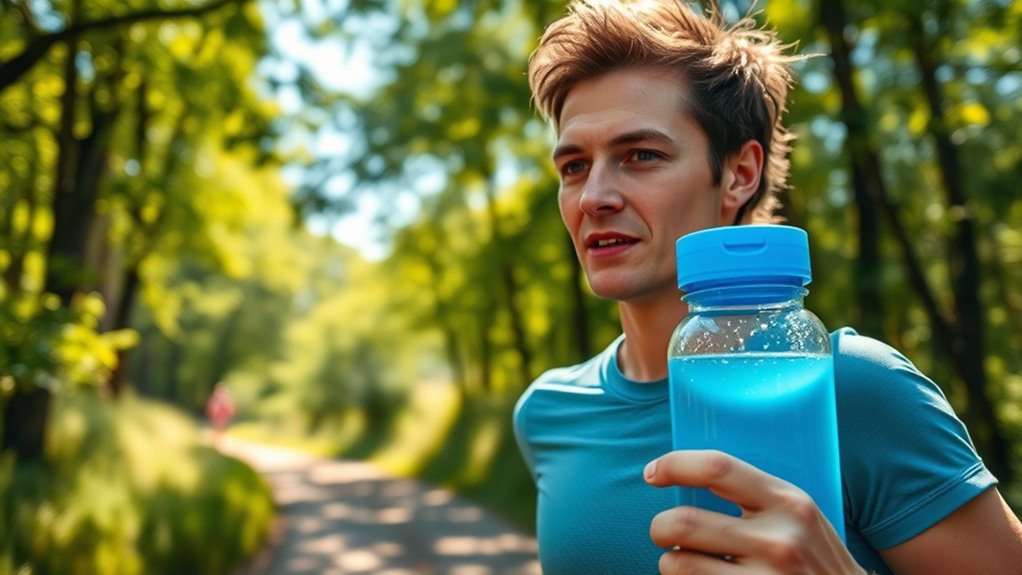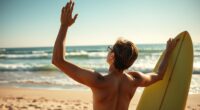To stay hydrated during hot-weather training, start by drinking 200-300 ml of water 15–20 minutes before your workout, then sip regularly every 15–20 minutes. Incorporate hydrating foods like watermelon or cucumber, and replenish lost electrolytes with sports drinks or by adding salt to your water. Watch for signs of dehydration, like dark urine or dizziness, and hydrate promptly afterward. Keep these tips in mind to optimize your hydration strategy and perform safely—more tips lie ahead!
Key Takeaways
- Hydrate early and regularly, sipping water or electrolyte drinks every 15-20 minutes during training.
- Consume hydrating foods like watermelon, oranges, and cucumber to boost fluid intake naturally.
- Replenish lost fluids promptly post-exercise with electrolyte-enhanced beverages based on sweat loss.
- Monitor urine color and body signals to detect dehydration early and adjust hydration accordingly.
- Add natural electrolytes, like sea salt or electrolyte tablets, to water for better mineral balance during hot-weather workouts.
Know Your Hydration Needs Before Exercising
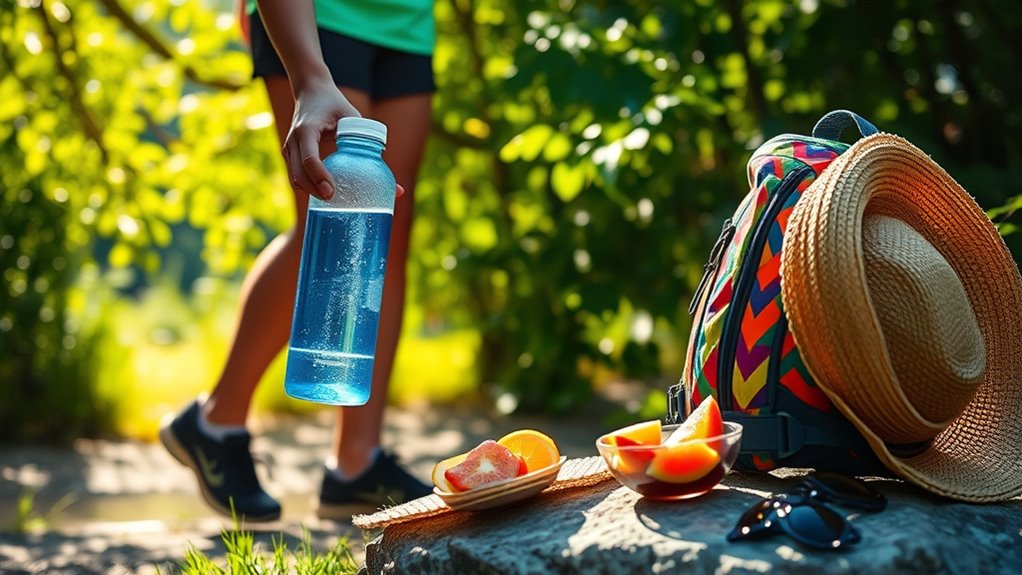
Knowing how much water you need before exercising is essential for staying energized and avoiding dehydration. Many hydration myths circulate, making it confusing to determine your true needs. To start, understand your sweat rate, which varies from person to person. If you tend to sweat heavily, you’ll need to hydrate more to replace lost fluids. On the other hand, if you sweat less, a smaller amount may suffice. Don’t rely on generalized guidelines or myths that suggest drinking excessive amounts before workouts. Instead, monitor your body’s signals and consider weighing yourself before and after exercise to estimate how much fluid you lose. This personalized approach helps you stay properly hydrated, ensuring ideal performance and reducing the risk of dehydration during hot-weather training. Knowing your hydration needs can also help you develop a more effective plan for electrolyte intake and fluid replacement. Additionally, paying attention to body cues like thirst and color of urine can further refine your hydration strategy. Incorporating hydration tracking devices can provide even more precise insights into your hydration status, optimizing your training outcomes.
Time Your Fluid Intake Strategically
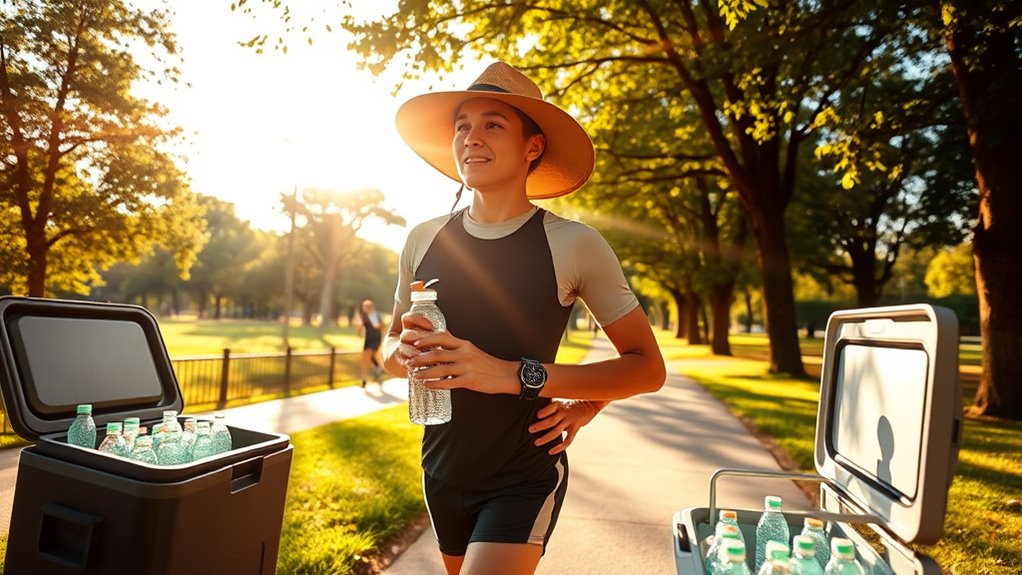
To stay properly hydrated, you should plan your fluid intake around your activity. Drinking a little before you start, sipping regularly during exercise, and rehydrating afterward helps maintain your performance and recovery. Timing your fluids guarantees you stay energized and avoid dehydration. Incorporating expert voice actors in your training videos can also enhance viewer engagement and credibility. Additionally, using energy-efficient heat pump systems can help maintain a comfortable indoor environment, preventing overheating and reducing the strain on your hydration needs during extreme weather conditions.
Drink Before Exercise
Have you ever wondered why drinking water before exercise can boost your performance? Proper hydration timing ensures you’re not starting dehydrated. About 15-20 minutes before your workout, sip water or a pre exercise snack that contains fluids. This helps maximize hydration levels and prevents early fatigue. Here’s a quick guide:
| Hydration Tip | Recommended Action | Why It Helps |
|---|---|---|
| Drink water | 200-300 ml before exercise | Boosts hydration levels |
| Eat a hydrating snack | Fruits or yogurt with fluids | Maintains hydration during activity |
| Time your intake | 30-60 mins apart from the start | Ensures ideal hydration |
Additionally, understanding the importance of contrast ratio in your hydration strategy can help you better interpret your body’s signals and optimize your performance.
Furthermore, considering tuning options for your vehicle can also improve overall efficiency and responsiveness, just like timing your hydration enhances your workout.
Being aware of your body’s hydration signals allows you to adjust your fluid intake as needed, ensuring optimal performance and recovery.
Sip During Activity
During exercise, sipping fluids at strategic intervals helps maintain ideal hydration and performance. To stay motivated, choose from a variety of flavor options to make drinking more enjoyable. Carry your fluids in reusable bottles to guarantee easy access and reduce waste. Aim to take small, consistent sips every 15 to 20 minutes, especially in hot weather. This helps prevent dehydration and keeps your energy levels steady. Using a reusable bottle with a built-in straw or wide mouth can make sipping more convenient during activity. Experiment with different flavors to find what keeps you drinking throughout your workout. Incorporating hydration benefits can make hydration more appealing and enjoyable. Staying well-informed about resources and tools available for hydration can further enhance your training routine. Incorporating fabric decorating markers can add a personal touch to your workout gear, making hydration even more motivating. Remember, staying hydrated isn’t just about quantity but also about timing and flavor to make the process both effective and enjoyable.
Rehydrate Post-Workout
After your workout, rehydrating promptly is vital to restore lost fluids and support recovery. Drinking fluids soon after exercise helps re-establish electrolyte balance, which is essential for muscle function and preventing cramps. Pay attention to hydration monitoring by noting the color of your urine—light or clear indicates good hydration. To optimize rehydration, include beverages with electrolytes, such as sports drinks, rather than plain water alone. This helps replenish sodium, potassium, and other minerals lost through sweat. Aim to drink about 16-24 ounces of fluid for every pound lost during activity. Using proper hydration techniques can significantly enhance your recovery process. Incorporating proper hydration strategies also supports overall health and athletic performance in challenging conditions. Understanding electrolyte balance can further improve your rehydration effectiveness. Additionally, selecting the right yarn weight and stitch type can help you tailor your recovery routines for better comfort and performance.
Enhance Hydration With Electrolytes
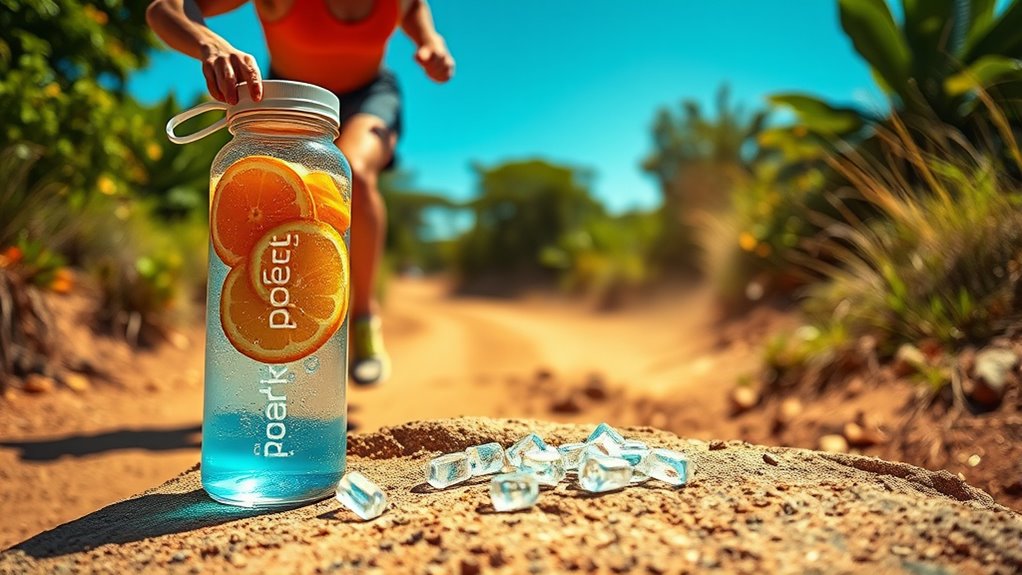
Electrolytes play a crucial role in optimizing hydration by helping your body absorb and retain fluids more effectively. Maintaining electrolyte balance ensures your muscles function properly and prevents cramps during hot-weather training. To enhance hydration with electrolytes, focus on mineral replenishment through these key strategies: 1. Drink sports drinks or electrolyte-infused water that contain sodium, potassium, and magnesium. 2. Add a pinch of sea salt to your water for a natural electrolyte boost. 3. Use electrolyte tablets or powders when you sweat heavily or train for extended periods. Incorporating electrolyte balance into your routine supports overall hydration and performance. Recognizing the significance of soulmate angel numbers can also inspire a positive mindset during your training journey. Ensuring proper hydration strategies can make a significant difference in maintaining your energy levels and preventing dehydration during intense workouts. Additionally, choosing natural essential oils such as peppermint or eucalyptus can help invigorate your senses and improve mental clarity during training sessions.
Incorporate Hydrating Foods Into Your Diet
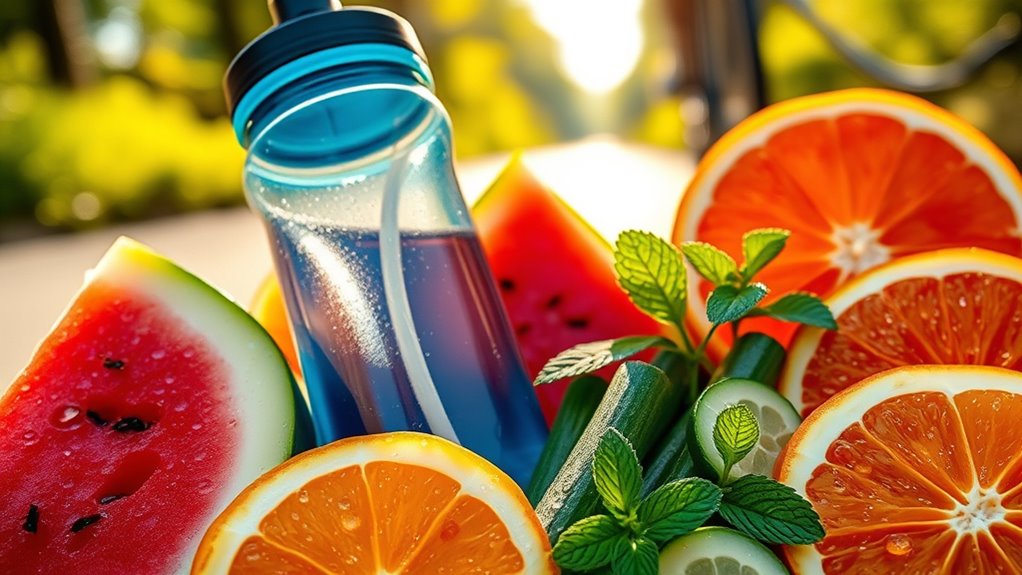
You can boost your hydration levels naturally by including foods with high water content in your diet. Fruits to boost hydration are especially effective because they provide both water and essential nutrients. Watermelon, strawberries, cantaloupe, and oranges are great options that help keep you hydrated during hot-weather training. Incorporating hydrating snack ideas like cucumber slices, celery sticks, or a bowl of fresh berries to maintain fluid levels throughout the day. These foods not only hydrate but also provide vitamins and minerals that support your overall health and performance. Eating a variety of hydrating foods makes it easier to stay refreshed without relying solely on drinks. Additionally, incorporating size restrictions of these foods can optimize hydration during your workouts and prevent dehydration. By making these foods a regular part of your diet, you’ll naturally improve hydration and feel more energized during your workouts.
Recognize Signs of Dehydration During Workouts
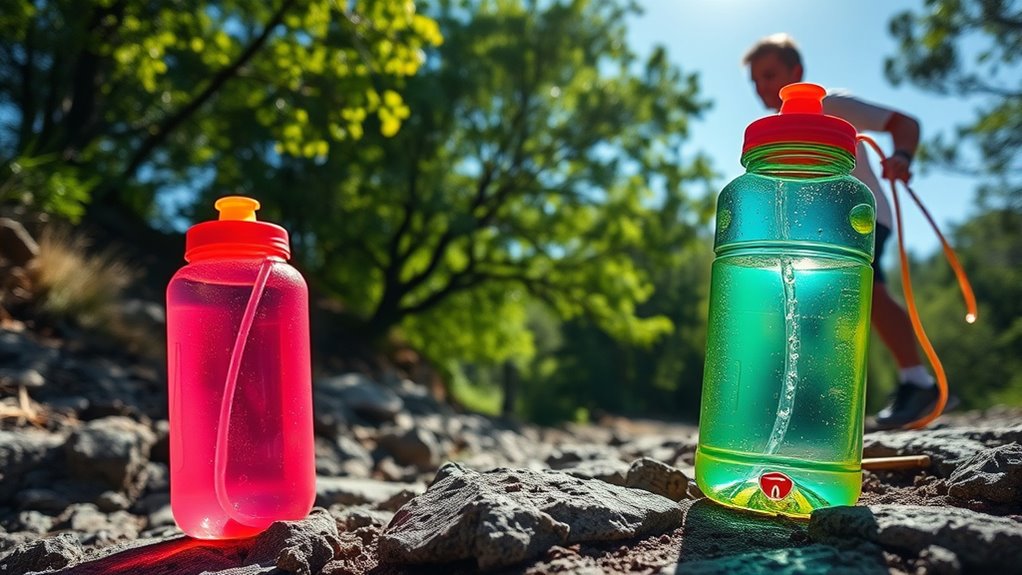
During your workout, it’s important to stay alert for signs that your body might be dehydrated. Recognizing these signs early can prevent serious issues like heat exhaustion or electrolyte imbalance. Watch for:
- Dizziness or lightheadedness, which indicates your electrolytes may be out of balance.
- Excessive sweating combined with weakness or nausea, signs of heat exhaustion.
- Dark urine or a sudden decrease in urination, signaling dehydration.
If you notice any of these symptoms, stop exercising, hydrate immediately, and seek shade. Staying aware helps you catch dehydration early and avoid complications. Remember, dehydration symptoms can escalate quickly in hot weather, so listening to your body is key to safe training.
Post-Workout Hydration Recovery Tips
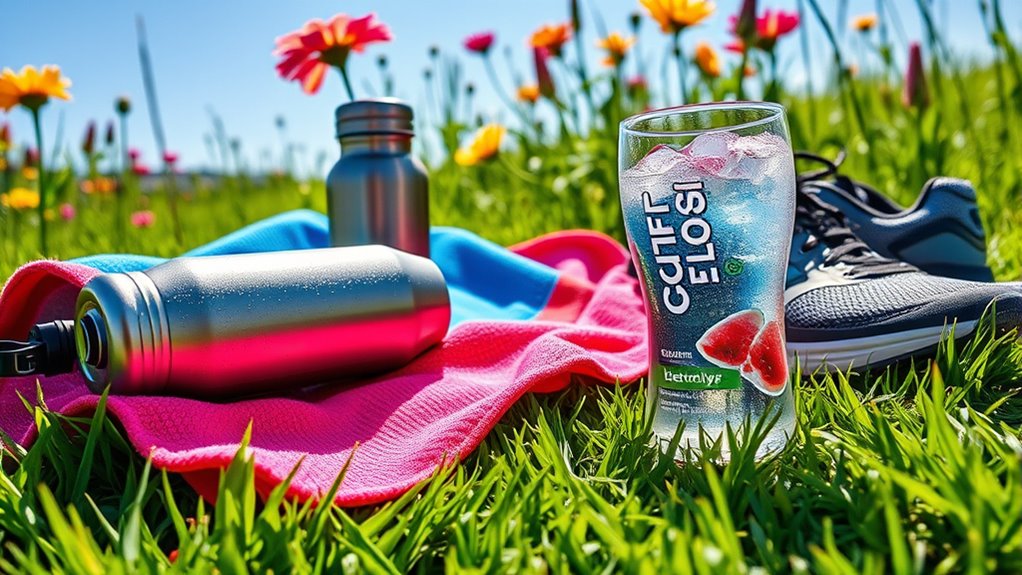
After finishing your workout, rehydrating promptly is essential to restore fluid balance and support recovery. Drinking fluids with electrolytes helps replenish lost minerals like sodium, potassium, and magnesium, which are crucial for maintaining electrolyte balance. Proper electrolyte levels improve fluid absorption, ensuring your body quickly restores hydration levels. Start with a sports drink or electrolyte-enhanced water within 30 minutes of exercise to maximize benefits. If you prefer plain water, consider adding a pinch of salt or consuming foods rich in electrolytes, such as bananas or yogurt. Avoid relying solely on water, as it can dilute electrolytes and hinder ideal fluid absorption. Prioritizing electrolyte balance and efficient fluid absorption accelerates recovery, reduces muscle cramps, and prepares you for your next workout.
Frequently Asked Questions
Can Hydration Needs Vary Based on Different Types of Exercise?
Your hydration needs definitely vary depending on the type of exercise you do. For high-intensity or long-duration workouts, you sweat more, which affects your electrolyte balance and increases fluid loss. Your sweat rate also influences how much you need to drink. By paying attention to these factors, you can adjust your hydration strategy to stay energized and prevent dehydration, especially during different types of exercise.
What Are the Best Beverages Besides Water for Hydration?
Besides water, you should consider electrolyte drinks and herbal infusions to stay hydrated. Electrolyte drinks replenish essential minerals lost through sweat, helping maintain your energy and muscle function. Herbal infusions, like chamomile or mint, offer flavor and hydration without added sugars. These beverages can make hydration more enjoyable, especially during intense workouts or hot weather, ensuring you stay replenished and comfortable while exercising.
How Does Altitude Affect Hydration Requirements During Workouts?
Like Icarus flying too close to the sun, you need to adjust your hydration at altitude. Higher elevations mean lower oxygen levels, making your body work harder and increasing dehydration risk. You’ll sweat more and lose fluids faster, so drink more to prevent altitude sickness. Keep an eye on your body’s signals and hydrate consistently, because at high altitude, even slight dehydration can turn into a bigger problem.
Are There Specific Hydration Strategies for Different Age Groups?
Age-specific hydration is vital because your body’s needs change over time. For seniors, hydration for seniors involves drinking smaller amounts more frequently and including electrolytes to prevent dehydration. Younger individuals might focus on maintaining consistent hydration throughout workouts. You should listen to your body’s signals and adjust intake accordingly, ensuring you stay well-hydrated regardless of age. Tailoring hydration strategies helps optimize performance and health at every stage of life.
How Can I Tell if My Hydration Plan Is Effective?
To tell if your hydration plan hits the mark, watch for signs like clear urine, steady energy, and minimal thirst. You want to maintain electrolyte balance and optimize hydration timing. If your urine stays light-colored and you feel energized without cramps, you’re likely on point. Conversely, dark urine, fatigue, or headaches suggest you need to tweak your intake. Regularly assess and adjust to keep your hydration healthy and effective.
Conclusion
Staying hydrated in hot weather is key to safe, effective training. For example, imagine you’re running a marathon and neglect hydration; dehydration can slow you down or cause serious health issues. By knowing your needs, timing fluids right, and including electrolytes and hydrating foods, you set yourself up for success. Remember, listening to your body and rehydrating properly after workouts keeps you strong and ready for your next challenge. Stay smart, stay hydrated!

